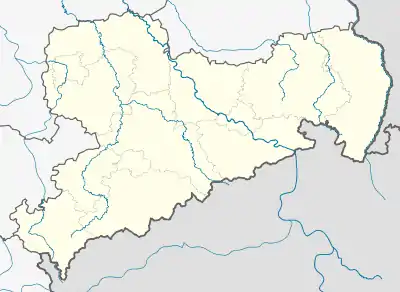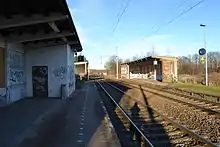Oberrothenbach | |
|---|---|
Location of Oberrothenbach | |
 Oberrothenbach  Oberrothenbach | |
| Coordinates: 50°46′00″N 12°28′20″E / 50.76667°N 12.47222°E | |
| Country | Germany |
| State | Saxony |
| District | Zwickau |
| Town | Zwickau |
| Population (2018-12-31)[1] | |
| • Total | 647 |
| Time zone | UTC+01:00 (CET) |
| • Summer (DST) | UTC+02:00 (CEST) |
Oberrothenbach (German pronunciation: [ˈo:bɐ̯ʁɔtn̩ˌbax]) is a village (Ortsteil) and former municipality in Saxony, Germany. It was incorporated into the municipality of Zwickau in 1999.[2] Its population was 647 in 2018.[1] Oberrothenbach is situated on the left bank of the Zwickauer Mulde, 6 km north of the centre of Zwickau.
History

Oberrothenbach was first established sometime in the Early Middle Ages. Local legend tells that a small village and bishopric was first attempted by a disciple of Saint Boniface. The disciple saw an apparition of the Virgin Mary appear on the local lake and speak to him, "Here you will build a haven for laborers."[3] However, the settlement was later overrun by migrating pagan Slavic tribes around the 9th century AD. The settlement later flourished as a mining area by the Late Middle Ages. During the Industrial Revolution in the German Empire, industrial mineral mining would be established in the town and many moved to Oberrothenbach to work.[3]
After the end of World War II, the Soviet Union secretly set up an industrial operation in Occupied Germany and later East Germany, particularly in the villages of the region such as Wismut and Oberrothenbach. Before the end of the Cold War and fall of the communist regime, over 20,000 workers died from harsh labor, radiation and other pollution. Conditions were so bad, the local saying of the region was "Kumpels sterben früher", German for "miners die young".[4][3]
Although the operation is now abandoned, the effects last to this day. About 450,000 people worked in the factories and mines in the village's history. Exposed to radon, arsenic, radioactive dust, lead, and other toxic compounds, an estimated 10-15,000 deaths are expected from illnesses such as cancer. A barbed-wire fence was built around the local polluted lake in the 1980s, which no longer supports most life.[3]
Today


Oberrothenbach is a quiet village within Zwickau, hosting approximately 700 inhabitants, mainly working-class. The population was less than 400 in 1993.[4] The village hosts several events and attractions for tourists such as festivals common in German culture.
Population
| Year | Pop. | ±% p.a. |
|---|---|---|
| 1999 | 689 | — |
| 2000 | 664 | −3.63% |
| 2001 | 661 | −0.45% |
| 2002 | 676 | +2.27% |
| 2003 | 660 | −2.37% |
| 2004 | 643 | −2.58% |
| 2005 | 618 | −3.89% |
| 2008 | 625 | +0.38% |
| 2010 | 646 | +1.67% |
| 2014 | 641 | −0.19% |
| 2018 | 647 | +0.23% |
| Source: Stadt Zwickau[5][1] | ||
References
- 1 2 3 "Aktuelle Einwohnerversammlung Stadtbezirk NORD" (PDF). Stadt Zwickau. Retrieved 23 September 2021.
- ↑ Gebietsänderungen vom 01.01. bis 31.12.1999, Statistisches Bundesamt
- 1 2 3 4 Bernstein, Leonard (1996). Environmental Science: Ecology and Human Impact (2nd ed.). Addison-Wesley Longman. ISBN 978-0201468885.
- 1 2 Marshall, Eliot (22 January 1993). "A Grisly Archive of Key Cancer Data" (PDF).
- ↑ Städtebauliches Entwicklungskonzept der Stadt Zwickau 2020 (June 2006).
External links
 Media related to Oberrothenbach at Wikimedia Commons
Media related to Oberrothenbach at Wikimedia Commons- Oberrothenbach im Digitalen Historischen Ortsverzeichnis von Sachsen